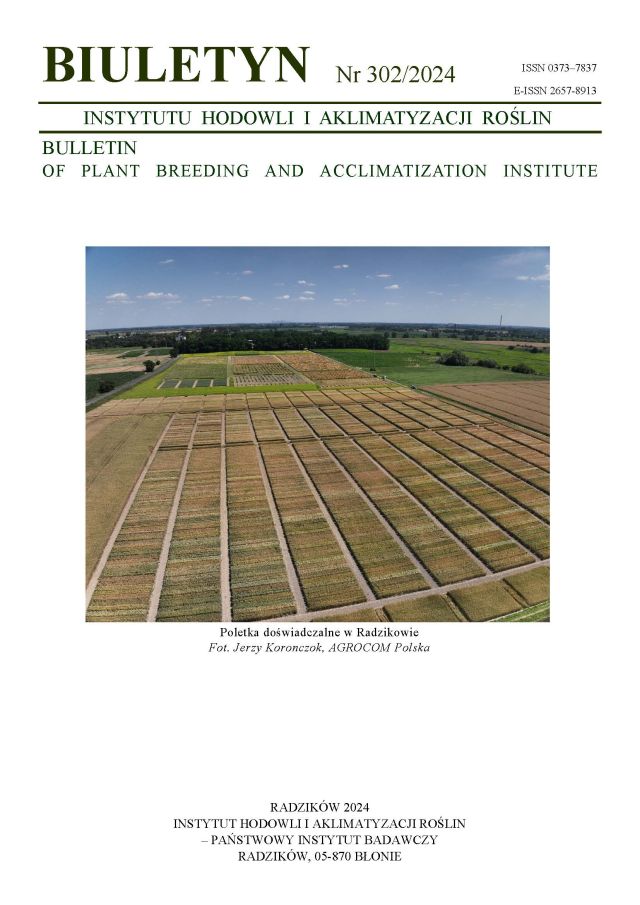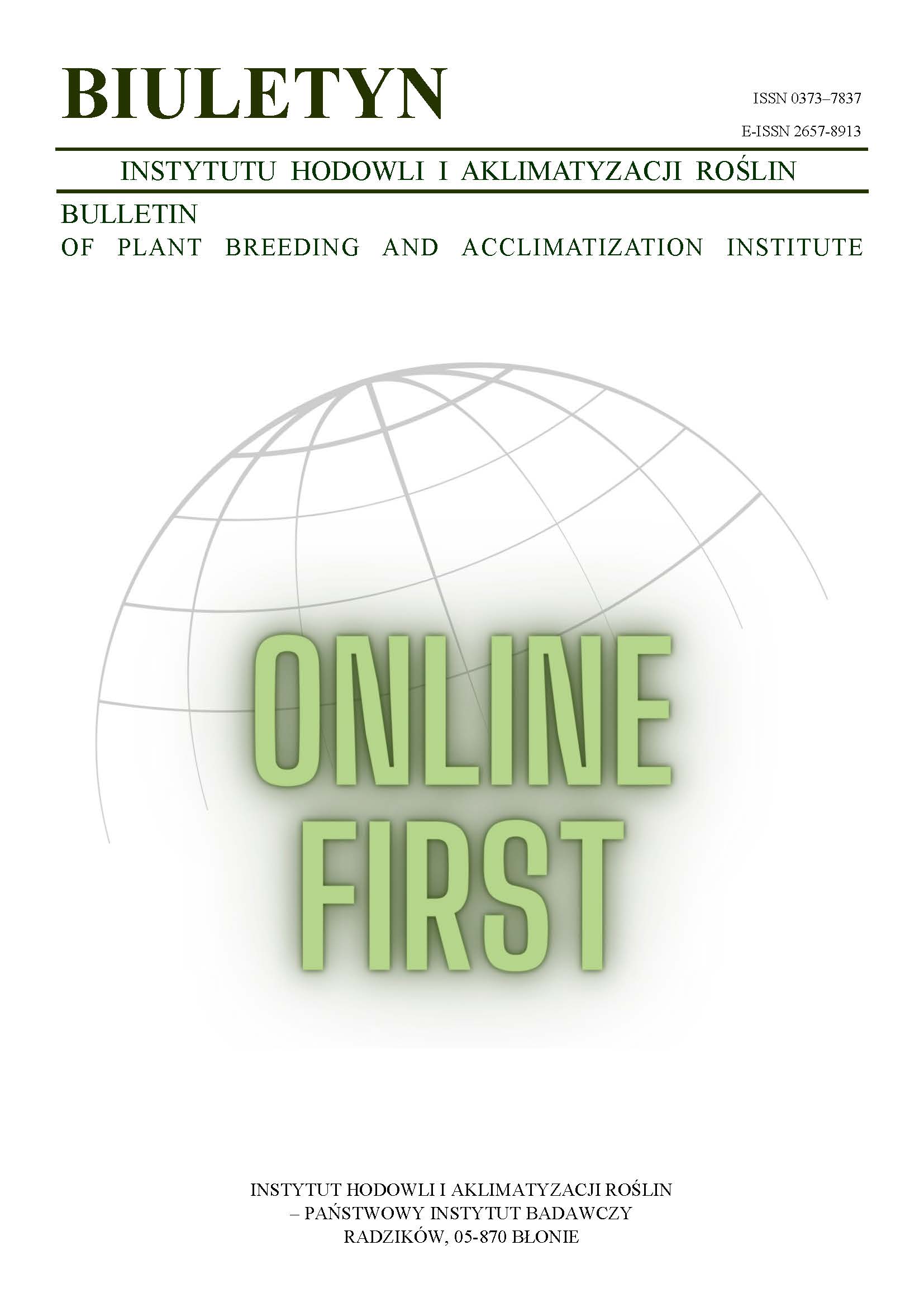Influence of nitrogen fertilization on the occurrence of important diseases on potato tubers
Bożena Cwalina-Ambroziak
bambr@uwm.edu.plKatedra Fitopatologii i Entomologii, Uniwersytet Warmińsko-Mazurski w Olsztynie (Poland)
Edward Wróbel
Katedra Produkcji Roślinnej, Uniwersytet Warmińsko-Mazurski w Olsztynie (Poland)
Abstract
The studies on tuber health were conducted on three table potato cultivars: very early Bard, medium-late Rybitwa and late Wawrzyn. The tubers were obtained in a precise plot trial, performed in the years 2000–2002 by the Department of Plant Production, University of Warmia and Mazury in Olsztyn, in Tomaszkowo. The experimental factors were combinations with nitrogen fertilization at a rate of 30, 60 and 90 kg/ha, in the form of 46% urea, applied after plant emergence. Tuber health was determined after five-month storage. The symptoms of common scab and black scurf were evaluated on 100 tubers selected at random from particular fertilization combinations, according to a nine-grade scale. The results are shown as the percentage infection index. A rate of tubers infestation by soft rot, late blight and dry rot was estimated in 5 kg samples for each combination, and presented in % of mass of infected tubers. The tubers were found to be infested at the level by common scab and black scurf in plants fertilized with nitrogen at a rate of 60 kg/ha. Climatic conditions in the vegetation seasons of 2000 and 2001 were conducive to the development of these diseases. The mean infection indices recorded for cv. Rybitwa were as high as 20% and 24%, respectively. The lowest level of infection by Streptomyces scabies and Rhizoctonia solani was observed in tubers of cv. Bard. The infestation of tubers by soft rot did not exceed 6%, and that by late blight and dry rot 3% only. The highest level of infection by Erwinia carotovora var. carotovora was recorded for cvs Bard and Wawrzyn, and that by Phytophthora infestans — for cv. Bard. In 2002 no symptoms of late blight were found on tubers of cv. Wawrzyn, irrespective of the level of fertilization, nor on tubers of the other cultivars at the lowest nitrogen rate. The incidence of dry rot was similar in all potato cultivars. Higher nitrogen rates resulted in a higher intensity of soft rot dry rot and late blight.
Keywords:
cultivars, diseases, nitrogen fertilization, tubers, potatoReferences
Ciećko Z., Krajewski W., Zabielska J. 1999. Charakterystyka składu aminokwasowego bulw ziemniaka w zależności od nawożenia azotowo-potasowego i fosforowego. Konf. Nauk. Ziemniak jadalny dla przetwórstwa spożywczego-czynniki agrotechniczne i przechowalnicze warunkujące jakość. Radzików, 23–25 lutego 1999: 90 — 92.
Google Scholar
Choroszewski P. 1988. Warunki infekcji bulw ziemniaka przez grzyby z rodzaju Fusarium. Biul. Inst. Ziemn. 43: 105 — 112.
Google Scholar
Choroszewski P. 1993. Wpływ warunków klimatycznych na porażenie bulw ziemniaka sprawcami chorób w latach 1979–1988. Biul. Inst. Ziemn., 43: 113 — 129.
Google Scholar
Cwalina-Ambroziak B. 2002. Grzyby zasiedlające bulwy ziemniaka (Solanum tuberosum L.) bezpośrednio po zbiorze i po przechowywaniu. Acta Agrobot. 56 (2): 133 — 140.
Google Scholar
Czajka W. 1988. Badania nad występowaniem ważniejszych bakteryjnych i grzybowych chorób ziemniaka na tle wybranych czynników agrotechnicznych oraz zabiegów chemicznych. Acta Acad. Agricult., Tech. Olst. Agricultura Supl. C 44: 1 — 58.
Google Scholar
Czajka W., Majchrzak B., Kurowski T. 1991. Wpływ nawożenia azotem na zdrowotność przechowywanych bulw ziemniaka. Acta Acad. Olst., Agricultura, 52: 219 — 228.
Google Scholar
Fiedorow Z., Weber Z. 1994. Diagnostyka chorób roślin. Choroby buraka i ziemniaka. Wyd. AR Poznań.
Google Scholar
Kuczyńska J. 1993. Rola grzybów Alternaria alternata (Fr.) Keissler, Colletotrichum coccodes (Wallr) Hughes i Geotrichum candidum Link. w wywoływaniu mieszanych zgnilizn bulw ziemniaka. Biul. Inst. Ziemn., Bonin 42: 91 — 105.
Google Scholar
Kurzawińska H. 1997. Fungi occurring in potato tubers with dry rot symptoms. Phytopathol. Pol. 13: 79 — 84.
Google Scholar
Zarzycka H. 1990. Grzyby jako pasożyty okolicznościowe na materiałach hodowlanych ziemniaków w Młochowie. Phytopathol. Pol. 11: 40 — 44.
Google Scholar
Wojciechowska-Kot H., Czajka W., Wiwart M. 1987 a. Stan zdrowotny ziemniaka w uprawie ciągłej. Acta Acad. Agricult., Tech. Olst., Agricultura 44: 191 — 204.
Google Scholar
Wojciechowska-Kot H., Kiszczak E., Markiewicz E. 1987 b. Patogeniczność izolatów Fusarium sulphureum Schl. Zesz. Probl. Post. Nauk Roln. 307: 323 — 334.
Google Scholar
Authors
Bożena Cwalina-Ambroziakbambr@uwm.edu.pl
Katedra Fitopatologii i Entomologii, Uniwersytet Warmińsko-Mazurski w Olsztynie Poland
Authors
Edward WróbelKatedra Produkcji Roślinnej, Uniwersytet Warmińsko-Mazurski w Olsztynie Poland
Statistics
Abstract views: 61PDF downloads: 17
License
Copyright (c) 2005 Bożena Cwalina-Ambroziak, Edward Wróbel

This work is licensed under a Creative Commons Attribution-ShareAlike 4.0 International License.
Upon submitting the article, the Authors grant the Publisher a non-exclusive and free license to use the article for an indefinite period of time throughout the world in the following fields of use:
- Production and reproduction of copies of the article using a specific technique, including printing and digital technology.
- Placing on the market, lending or renting the original or copies of the article.
- Public performance, exhibition, display, reproduction, broadcasting and re-broadcasting, as well as making the article publicly available in such a way that everyone can access it at a place and time of their choice.
- Including the article in a collective work.
- Uploading an article in electronic form to electronic platforms or otherwise introducing an article in electronic form to the Internet or other network.
- Dissemination of the article in electronic form on the Internet or other network, in collective work as well as independently.
- Making the article available in an electronic version in such a way that everyone can access it at a place and time of their choice, in particular via the Internet.
Authors by sending a request for publication:
- They consent to the publication of the article in the journal,
- They agree to give the publication a DOI (Digital Object Identifier),
- They undertake to comply with the publishing house's code of ethics in accordance with the guidelines of the Committee on Publication Ethics (COPE), (http://ihar.edu.pl/biblioteka_i_wydawnictwa.php),
- They consent to the articles being made available in electronic form under the CC BY-SA 4.0 license, in open access,
- They agree to send article metadata to commercial and non-commercial journal indexing databases.
Most read articles by the same author(s)
- Małgorzata Gołębiewska, Edward Wróbel, The effect of nitrogen fertilization on yielding of maize , Bulletin of Plant Breeding and Acclimatization Institute: No. 251 (2009): Regular issue
- Małgorzata Gołębiewska, Edward Wróbel, Effect of nitrogen fertilization on yield and quality of whole maize plants for silage , Bulletin of Plant Breeding and Acclimatization Institute: No. 256 (2010): Regular issue
- Bożena Cwalina-Ambroziak, Bożena Bogucka, Aldona Trojak, Infestation of some potato cultivars by Colletotrichum coccodes (Wallr.) Hughes at different levels of nitrogen fertilization , Bulletin of Plant Breeding and Acclimatization Institute: No. 246 (2007): Regular issue
- Edward Wróbel, Tadeusz Krajewski, Wojciech Krajewski, The effect of nitrogen application on yield and its structure of naked and hulled oats , Bulletin of Plant Breeding and Acclimatization Institute: No. 229 (2003): Special issue
- Bożena Cwalina-Ambroziak, Edward Wróbel, Influence of various factors on the composition of fungal flora colonizing potato phyllosphere , Bulletin of Plant Breeding and Acclimatization Institute: No. 232 (2004): Regular issue
- Edward Wróbel, Tadeusz Krajewski, Marek Krajewski, Yield and fodder value of naked oats grain in pure sowing and in mixtures , Bulletin of Plant Breeding and Acclimatization Institute: No. 229 (2003): Special issue














